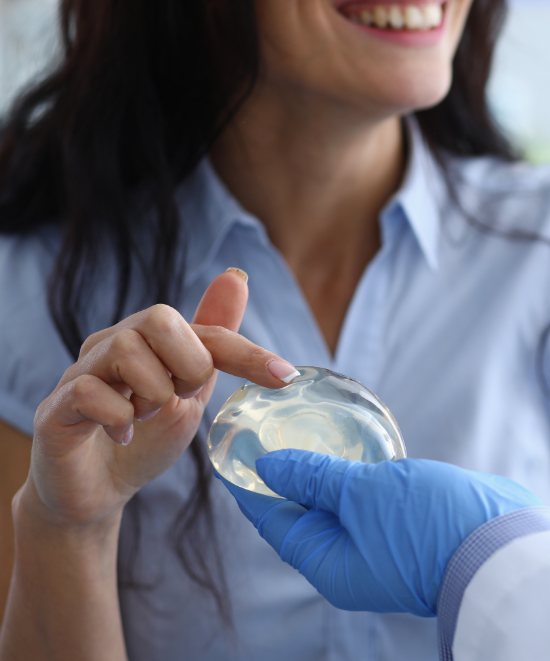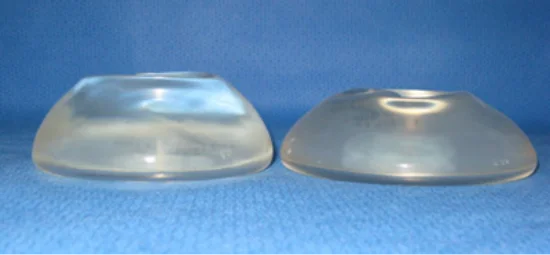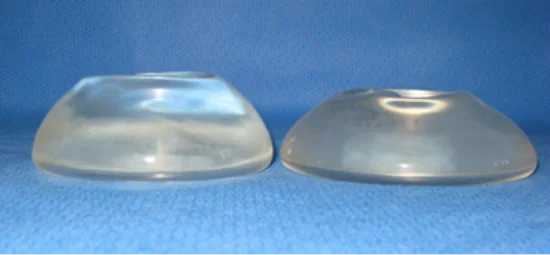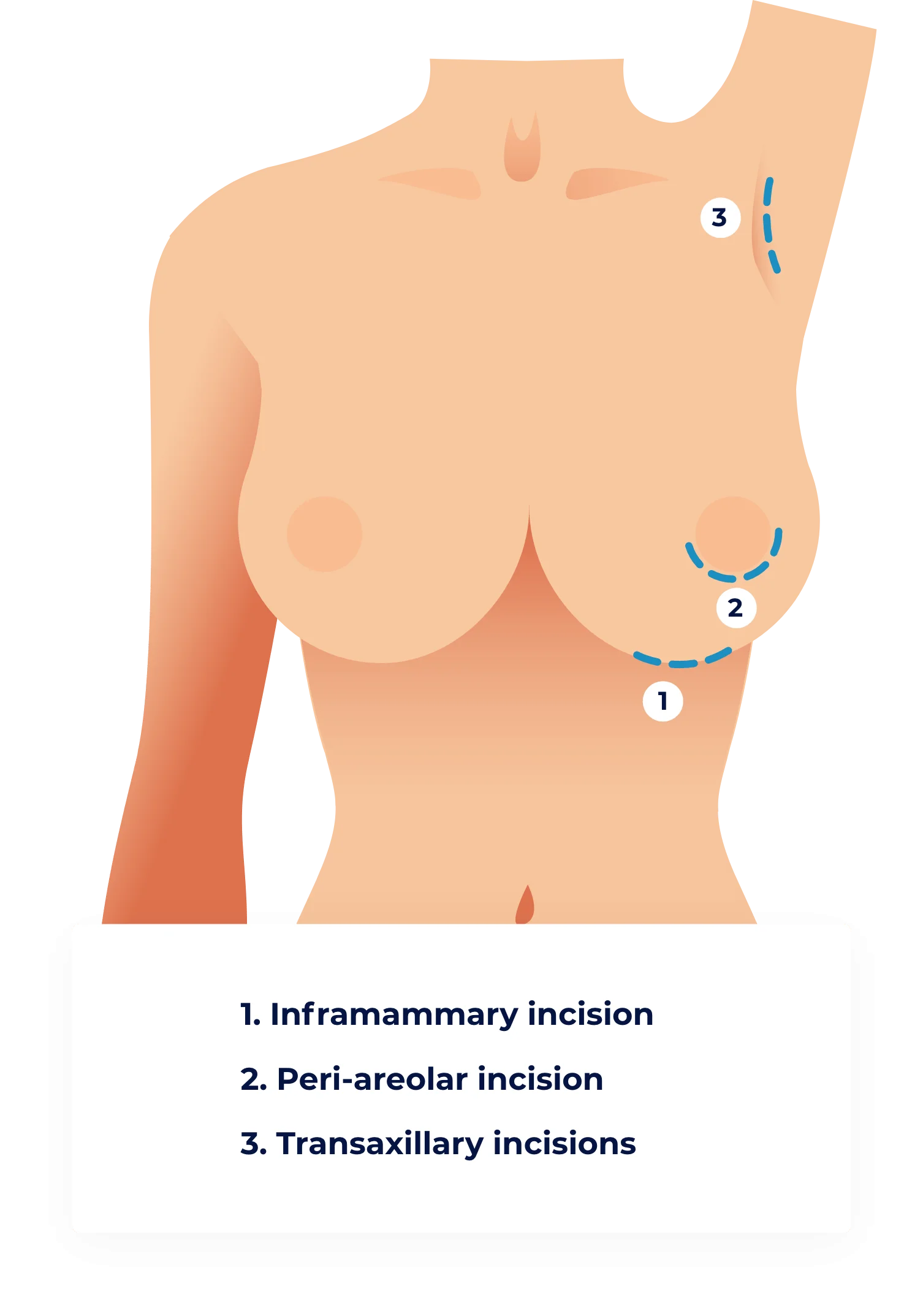Home|Breast Procedures|Cosmetic Breast Surgery|Breast Augmentation
Breast Augmentation
Breast augmentation is the procedure designed to enhance and enlarge the breasts using implants. The concept behind the procedure may sound rather simple and straightforward but the inherent considerations, issues and decisions and, ultimately, the surgical skill required for the desired transformation are far more complex and comprehensive. The reason for this is that there are many options and factors that must be considered and decisions made prior to surgery so as to maximize the likelihood of you obtaining the desired results.
Different patients have different goals in mind when they decide to undergo breast augmentation. Regardless of the underlying motivations, the procedure is perennially ranked around number one or two as the most popular cosmetic procedure available. It also has among the highest satisfaction rates of any procedure. In fact, on the website RealSelf.com, 98% of patients rated breast augmentation as well worth it.
The goals of breast augmentation surgery are to select the appropriate implant for volume and profile in order to obtain the desired breast size, shape and projection and to do so with incisions that are as inconspicuous as possible. To achieve this, the plastic surgeon must have an exceptional eye for aesthetic norms and issues, an appreciation of each patient’s tissue characteristics, an understanding of the three dimensional effects of the implants on the tissues, consideration for the changes over time, extensive experience and superior surgical skills. Equally important, he/she must be able to thoroughly understand and interpret his/her patient’s goals, needs and concerns so as to be able to deliver the desired outstanding results (see blog: Breast Augmentation and “Natural” Looking Breasts).
Dr. Steven H. Turkeltaub always strives to ensure that the results he creates for his patients are exactly what they desire.
- What is a Breast Augmentation?
- What are the Benefits of a Breast Augmentation?
- Who is a Good Candidate for Breast Augmentation?
- What are My Breast Implant Options?
- What is Involved in the Breast Augmentation Procedure?
- What is Recovery Like After a Breast Augmentation?
- Will I Have Breast Augmentation Scars?
- How to Choose a Breast Augmentation Surgeon
- How Much Does a Breast Augmentation Cost?
- Breast Augmentation Before-and-After Photos
- Breast Augmentation Patient Testimonials
- Frequently Asked Questions
- Additional Information About Breast Augmentation from Dr. Turkeltaub’s Blog
- Allergan Breast Implant Warranty
What Is a Breast Augmentation?
Breast augmentation (also known as augmentation mammoplasty, breast enlargement or breast enhancement) is the surgical procedure that allows a woman to increase the size and improve the shape and appearance of her breasts. This is accomplished using breast implants, which can be placed either behind or in front of the pectoral (chest) muscles in order to enhance the shape, size and overall projection of the breast.
These implants come in a variety of sizes, shapes, textures and materials and Dr. Turkeltaub can help you select the optimal implants for your aesthetic goals. He has decades of experience delivering exceptional breast augmentation results for his patients and is widely regarded as a top breast surgeon in Arizona.
There are many reasons that someone may choose to have a breast augmentation. A lot of women undergo the procedure because they either had little breast development or never attained the size that they desired. Others lost volume and firmness following weight loss, pregnancy or breastfeeding. In other cases, the natural decline in estrogen production that comes with aging causes the breasts to deflate or shrink.
Regardless of the reason you are seeking breast enhancement, Dr. Turkeltaub can help you obtain fuller, shapelier breasts that accentuates your figure while remaining proportionate and natural-looking.
What are the Benefits of a Breast Augmentation?
Breast augmentation can provide patients with a range of potential benefits, including:
- Enhanced breast size and shape
- Improved breast symmetry
- Restoration of breast volume after pregnancy, breastfeeding, weight loss and/or aging
- Customizable results based on a patient’s desired aesthetic
- A more balanced and proportional figure
- Greater self-confidence
Who is a Good Candidate for Breast Augmentation?
Breast augmentation is generally well-suited for individuals seeking to enhance breast size, improve symmetry and/or restore volume lost due to aging, weight changes or pregnancy. Ideal candidates are healthy non-smokers with realistic expectations about the outcomes and potential risks. Dr. Turkeltaub can help you make decisions regarding implant types and sizes for a beautiful, natural-looking result.
Those undergoing breast reconstruction post-mastectomy or correcting congenital malformations may also benefit from breast implants. During a consultation, Dr. Turkeltaub will discuss the different breast reconstruction options with you to ensure you are making the optimal choice for your health and well-being.
In addition to traditional breast augmentation, Dr. Turkeltaub also offers MTF transgender top surgery. This procedure involves the placement of implants to help transwomen obtain a fuller, more feminine chest appearance.
What are My Breast Implant Options?
Today, breast implants are available in a seemingly limitless array of sizes, shapes, projections, fill material including different degrees of silicone gel cohesiveness. At the Arizona Center for Aesthetic Plastic Surgery, Dr. Turkeltaub makes available to his patients most of these implant choices so that they can have the opportunity to achieve the beautiful, natural-looking breast enhancement results that they desire. Selecting the right implants for your goals will be based on several different considerations that include your specific needs, the characteristics of your breast tissue, your unique anatomical indicators and the overall outcome that you are envisioning.
During the consultation with Dr. Turkeltaub, all of these factors will be examined and discussed thoroughly with you so as to be sure that the breast implants selected for you can effectively deliver the results you desire.
Silicone or Saline Breast Implants
The two types of breast implants available for breast enlargement are silicone and saline. The silicone implants are the “gold standard” with regard to the aesthetic outcome: they feel and generally look more natural and, on average, last longer than the saline implants. In addition, they are available in different degrees of cohesiveness which allows for even greater finesse and customization based on a patient’s specific situation and tissue characteristics which can lead to results that are even more superior.
Saline implants are frequently associated with skin rippling or implant palpability especially in those with thin skin and minimal breast tissue. Furthermore, the results don’t age as well as those who have silicone implants.
Virtually one hundred percent of Dr. Turkeltaub’s patients select the silicone implants for their breast augmentations. It is extremely rare anymore for a patient to specifically request a saline implant. Anecdotally, those patients who have had both types of implants at different points in time, every single one of them preferred, by far, the silicone implants over the saline ones.

Breast Implant Size
The number one thing that people think and talk about regarding breast augmentation is size and, more specifically, implant size. Though it is not the only important factor, size really does matter. When women are not thoroughly satisfied with their results following a breast enlargement, the number one reason relates to size and it is usually because they wanted to be larger. Therefore, it is crucial that the patient has an idea of the look that she wants to achieve, how it impacts the appearance and harmony of her body size and shape, the effects that the enhanced breast size may have on other aspects of her lifestyle and the image that will be projected.
 In Dr. Turkeltaub’s experience, most women today prefer to be proportional or slightly larger than proportional though there are others who request to be double “D’s” or larger. But what is “proportional”? This is an ambiguous term which will mean different things to different women. What is proportional to one woman may be either too small or too large (rarely) for another. Compounding this problem is the confusion as to what appearance different cup sizes represent since there are no universal standards. Consequently, bras of a specific cup size manufactured by different companies often do not fit the same. One company’s “C” cup may be the same size and shape as another company’s “D” cup.
In Dr. Turkeltaub’s experience, most women today prefer to be proportional or slightly larger than proportional though there are others who request to be double “D’s” or larger. But what is “proportional”? This is an ambiguous term which will mean different things to different women. What is proportional to one woman may be either too small or too large (rarely) for another. Compounding this problem is the confusion as to what appearance different cup sizes represent since there are no universal standards. Consequently, bras of a specific cup size manufactured by different companies often do not fit the same. One company’s “C” cup may be the same size and shape as another company’s “D” cup.
Dr. Turkeltaub finds that trying on implants and reviewing photos are very helpful though there are limitations. In the end, he finds that selecting the most appropriate size is both a science and an art.
For additional information about the importance of implant size, read Dr. Turkeltaub’s blog post: “Size Really Does Matter.”
Breast Implant Profile
Another important factor to consider when selecting the most appropriate implant is its profile.
What is an implant’s profile?
An implant’s profile is the ratio of its relative projection to its base width for a given volume. In English this means that at a given cc volume it can be broader with less projection or narrower with more projection. This is a very important parameter that must be considered in order to be able to obtain the best possible results. Though terminology can vary, implants come in ultra-high, high, moderate and low profile.

Figure 1a. This is a side view of implants of the same volume but different projections. The implant on the left side is a high profile implant and the one on the right is a moderate profile implant. Note the greater projection and narrower width of the high profile implant.
High profile breast implants will have greater projection and less width for a given size compared to moderate profile ones which are broader and less projecting. The style that would be most appropriate for you depends on many factors including your chest width and configuration; amount of breast tissue present; and the ultimate size, projection, shape, cleavage and overall appearance that you desire. (See Figure 1a and 1b.)

Figure 1b. Frontal view of the implants in Figure 1a. Note the greater width of the moderate profile implant on the right which projects less than the narrower high profile implant.
Breast Implant Shapes
The overwhelming majority of the breast implants used today for breast enlargement are round in shape. There may be certain rare situations related to anatomy, preferences and other factors where tear-dropped shaped silicone implants may be “better” suited. The “anatomic” style implants, of which the Allergan Natrelle® Style 410 (“gummy bear” implants) was one example, have a wedge shape that can be of varied vertical height and width that can provide for a more customized result in certain situations.
At one point in time, these anatomic implants seemed to be quite promising for their potential to allow for even more refined results. However, due to some untoward issues including the rare development of BIA-ALCL (Breast Implant Associated Anaplastic Large Cell Lymphoma) associated with the necessary surface texturing, it is Dr. Turkeltaub’s opinion that their usage should be rarely considered. He does not and will not use textured surfaced implants.

Breast Implant Surface Textures
For several good reasons, most breast implants placed in the United States now are smooth surfaced ones where the outer shell (envelope) around the implants has no texturing. Many years ago, before several significant technological advancements were made, it was a common experience and opinion held by many that using textured surfaced implants (where there were small 3D elevations on the implant surface) reduced the incidence of capsular contracture especially in higher risk patients (See Figure 2). Present scientific studies do not support this relationship. Furthermore, because of the risk of developing BIA-ALCL with textured implants, their widespread usage is inadvisable though they may still have a place in very limited situations.
Because of this risk, the Natrelle® Style 410 “gummy bear” implants were voluntarily taken off the market in July 2019.

Figure 2. The Silicone breast implant on the left is a smooth surface implant while the one on the right is a textured surfaced one.
Dr. Turkeltaub has been performing breast surgery with implants for many years and has the knowledge, skill and experience to precisely evaluate all variables and help you select the implants that can most effectively achieve the results that you desire.
What is Involved in the Breast Augmentation Procedure?
Breast augmentation surgery is performed under general anesthesia as an outpatient. The procedure typically takes around an hour followed by approximately one to one and a half hours in the recovery room. Dr. Turkeltaub uses a very gentle and precise technique which helps to minimize postoperative discomfort and the risk for non-ideal outcomes.
If your breasts are sagging, you may also need to have a breast lift (mastopexy) done as well—which can be referred to as a breast augmentation with a lift, mastopexy augmentation or a breast lift with implants. Tummy tucks and liposuction are commonly done at the same time as a breast augmentation as part of a “Mommy Makeover.”
Incision Location
There are three acceptable locations of the incisions for the insertion of the breast implants in breast augmentation. Each has advantages and disadvantages based on individual factors. (The belly button incision, also known as the transumbilical approach, is not considered for a variety of reasons.) These insertion sites are:
- Inframammary. This is the most common approach and involves an incision placed at the bottom of the breast, in or near the fold where it arises from the chest. This location provides the most flexibility both short- and long-term, superior visualization and exposure for surgery, more predictable results and a lower risk of developing capsular contracture compared to the other sites.
- Periareolar (infra-areolar). The incision is placed at or near the margin of the lower half of the areola where it borders normal breast skin. Some women indicate a preference for this location but they do need to consider some important issues before selecting it such as an increased risk for loss of sensation of the nipple, an elevated risk for the development of capsular contracture, postoperative scarring that can cause contour irregularities of the breast and scars that may be fairly conspicuous. Women with smaller sized areolas either cannot or should not consider this approach especially if using silicone implants.
- Transaxillary. Implants are inserted through an incision in the armpit with the big selling point being that there will be no scar located on the breast itself. When performed endoscopically, results can be good but there are several important issues and risks, such as an increased incidence of capsular contracture and implant malposition that must be discussed and considered before electing this option.

The incision chosen for the insertion of the breast implants can impact the ultimate sensation of the nipple after surgery. For more on this, read Dr. Turkeltaub’s blog post on breast augmentation incisions and nipple sensation.
Behind or in Front of the Muscle
Breast implants can be placed in a “pocket” either behind (deep to) the pectoralis major muscle on the chest wall (subpectoral or submuscular) or directly in front of it (submammary or pre-pectoral). The appearance and dynamics of the breasts are quite different between these two locations as are the consequences of gravity, weight fluctuations, implant size and time. The most significant advantages for placing the implants in a submuscular pocket include:
- Mammograms are usually more easily and accurately read versus when implants are situated in front of the muscle (submammary).
- The risk for developing capsular contracture (hardness of the breast caused by the formation of scar tissue around the implants) is lower.
- There is a greater amount of soft tissue coverage of the implant which translates into a decreased risk and extent of visible rippling as seen on the skin as well as buffering the ability to feel the implant.
- A superior and more natural interface is present between the implant and chest wall allowing for a more normal appearance rather than a fake, very round look.
- The muscle provides significantly better long-term support of the underlying implants as compared to skin only support when the implants are situated above the muscle. In a submammary location, the weight of the implant will cause a greater degree of stretching and thinning out of the skin over time resulting in more substantial drooping. This problem is exacerbated with very large implants.
Because of these important advantages of having the breast implants in a submuscular location, this is Dr. Turkeltaub’s recommendation for most of his patients.
What is Recovery Like After a Breast Augmentation?
A surgical dressing is placed following your breast augmentation that provides compression and more comfort for two to three days. This is then replaced by a sports type bra which is worn day and night for a week or more. A regular, comfortable and supportive bra can then be worn. Dr. Turkeltaub recommends that patients with relatively large implants wear a supportive bra on a regular basis to help maintain the breast shape and minimize drooping from the increased weight over time.
During the first few days after surgery, discomfort may be mild to moderate. Analgesics and a muscle relaxant are prescribed which will help make you more comfortable. Most patients can return to a non-strenuous job or school within a few days to a week. If your job requires heavy lifting or repetitive upper extremity movements (such as a hairdresser), modifications of your activity or greater time off from work are strongly recommended. You should avoid vigorous activities such as sports, aerobics and heavy lifting for at least three to four weeks and certain other exercises and activities (such as pectoralis major muscle exercises) for eight weeks. It is not uncommon to experience muscle tightness and even spasms early on but these usually resolve fairly quickly.
Your breasts initially will be swollen, firm and may appear larger than you were anticipating. Much of the swelling will subside after several weeks resulting in a more defined shape and a size closer to what you can expect long-term. With additional time, the skin and muscle (if the implants are in a submuscular location) will relax even more resulting in a softer, more natural feel and appearance.
Whether or not to pursue a breast augmentation is a highly personal decision that a woman must make for herself. There are clearly many long-term benefits of having a breast enlargement. Some of these include looking better, feeling more feminine and attractive, having greater self-esteem and being able to find clothes that fit and that are more complimentary. As stated already, the overwhelming majority of breast enlargement patients are extremely happy with their results.
Will I Have Breast Augmentation Scars?
The greatest determinant of the visibility of breast augmentation scarring is the incision technique utilized to perform surgery. Most commonly, Dr. Turkeltaub employs an inframammary incision that is made in or near the natural crease beneath the breast. The resulting scar is typically quite short in length and remains hidden underneath the breasts themselves. Other incision locations include inside the armpit (transaxillary) and around the lower perimeter of the areola (periareolar). While these two methods also yield relatively inconspicuous scars, Dr. Turkeltaub seldom uses them due to various risks and potential issues that can be covered in full detail at the time of your consultation.
Along with the specific incision method utilized, the overall appearance of breast augmentation scarring is also influenced by factors such as:
- Your plastic surgeon’s technical skill
- The incision closure method that your doctor utilizes
- How strictly you adhere to post-operative care instructions
- The type and quality of scar management products you use
- Your genetic makeup and natural response to healing
- Your diet and various other lifestyle habits
Ultimately, Dr. Turkeltaub has found that his breast augmentation patients seldom have any issues concerning scarring—especially when all post-surgical advice is closely followed and scar management treatments are employed as directed.
How to Choose a Breast Augmentation Surgeon
For patients seeking any type of aesthetic care, it is important to choose a surgeon with the requisite skill, experience and aesthetic compatibility to deliver the cosmetic results you desire. Furthermore, working with someone who makes you feel comfortable, confident and well-informed throughout the treatment process can elevate the experience and further enhance your surgical outcomes. The following steps can help you determine whether a provider is the right choice for your breast augmentation surgery.

- Review their credentials. A plastic surgeon’s credentials go beyond just their medical degree. Some other important things to look for include certification by the American Board of Plastic Surgery (also often referred to simply as “board certification”) and membership in prestigious professional organizations, such as the American Society of Plastic Surgeons (ASPS) and The Aesthetic Society (formerly known as the American Society for Aesthetic Plastic Surgery, or ASAPS). These components often indicate that a surgeon has displayed a track record of excellence and an ongoing commitment to professional development and education.
- Look at before-and-after photos. Viewing the results of former patients can give you a good idea of what to expect from your own procedure. Most reputable plastic surgeons will have a range of before-and-after photos available to view either on their website or upon request during a consultation.
- Read patient reviews. Reading what past patients have to say can offer valuable insight into both a surgeon’s ability to deliver satisfactory results and their overall approach to patient care.
- Schedule a consultation. Sometimes, the best way to know whether you are comfortable with a plastic surgeon is to meet them. Scheduling a consultation with a prospective provider allows you to ask any questions you may have while also getting a better understanding of a surgeon’s temperament.
How Much Does a Breast Augmentation Cost?
According to data gathered by RealSelf.com, the average cost of breast augmentation in Arizona is $8,614. While these numbers can give you a general idea of what you might expect to pay for treatment, exact pricing for breast augmentation will be impacted by a variety of different factors that include:
- Geographic location
- The specific implants selected
- Whether or not a breast lift is also performed
- The credentials, surgical skill and experience of the plastic surgeon
- The facility in which the procedure is performed
- Anesthesia fees
- Any necessary preoperative mammogram screenings
- Any medications needed during recovery
If you are interested in breast augmentation, Dr. Turkeltaub will be glad to meet with you at our practice for an in-person consultation. After evaluating your needs and goals and developing a personalized treatment plan, he can provide you with a price quote that includes an itemized breakdown of all associated fees. During your visit, a member of our staff can also introduce you to various breast surgery financing options we have available if desired.
Breast Augmentation Before-and-After Photos
Due to social media policies, the following images have been censored. Please click on the image below to view the image.
Breast Augmentation Patient Testimonial Videos
Frequently Asked Questions
Do silicone breast implants feel significantly more natural in general compared to saline implants for a breast enlargement?
Will I need to have my breast implants replaced sometime in the future?
Which type of implant lasts longer, silicone or saline?
Do most of your patients choose silicone implants over saline?
Will I also need a breast lift with my augmentation?
Is breast augmentation safe?
Does breast augmentation hurt?
I’ve heard about capsular contracture after breast augmentation. Is this something I should be worried about?
Will I still have sensation in my nipples?
Will I be able to breastfeed?
How do breast implants affect mammogram screenings?
How long after breast augmentation can I swim?
When can I sleep on my side after breast augmentation?
What type of bra should I wear after breast augmentation?
After this time frame, you can wear a bra that you find comfortable and supportive. If you have large implants, it is even more important to wear a good supportive bra on a regular basis.
Should I be concerned about BIA-ALCL or BII after breast augmentation?
Breast Implant Illness (BII) is not an official medical diagnosis, but some women have reported to experience symptoms after undergoing breast augmentation that they attribute to their implants. These symptoms are commonly associated with autoimmune disorders or connective tissue illnesses, such as weakness, fatigue, hair loss, cognitive dysfunction and more. Although breast implants have been thoroughly researched and tested for safety, these symptoms are very real and must be addressed with compassion and care. Breast implant removal (explantation) can be performed for anyone experiencing these effects or to alleviate any concerns that they may have though there may ultimately be no impact on any of the symptoms.
During your initial consultation, Dr. Turkeltaub will discuss all potential risks associated with breast implants and can provide detailed and personalized answers to any questions that you may have.
Additional Information About Breast Augmentation
Read more about breast augmentation from Dr. Turkeltaub’s breast surgery blog.
Contact Dr. Turkeltaub
For more information about breast augmentation, or if you are interested in scheduling a consultation, please contact Dr. Turkeltaub today.
